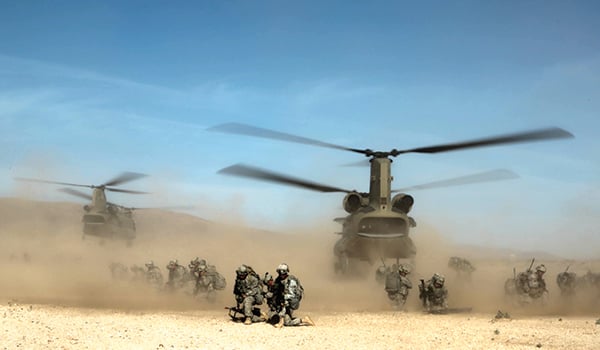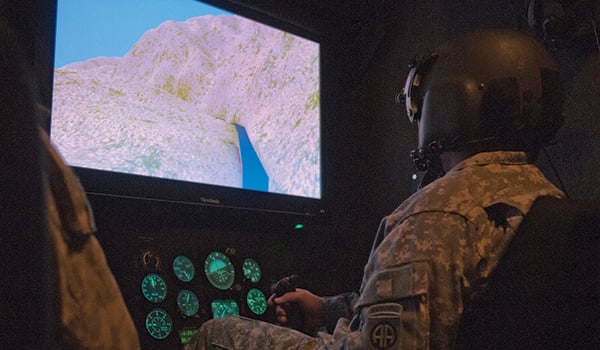
Training / By MAJ Trenten J. Short: The Army Operating Concept (AOC) lists our strategic goal as the nation’s Army: Win in a complex world, through force development by multiple factors. Although the AOC is a strategic document, it clearly identifies innovative and realistic training as a foundational tenet to the success of our nation’s Army. How do aircrew training program (ATP) commanders maximize training to support a strategic goal? The Directorate of Evaluation and Standardization (DES) has witnessed numerous outstanding units with engaged leadership execute focused, deliberate aviation training utilizing all available resources.

Soldiers from Alpha Company, 4th Battalion, 17th Infantry Regiment, 1st Stryker Brigade Combat Team, 1st Armored Division, offload from a CH-47 Chinook helicopter during Decisive Action Rotation 15-08 at the National Training Center on Fort Irwin, CA. / U.S. ARMYPHOTO BY SPC RANDIS MONROE
New requirements, such as Objective T, will help commanders assess realistic training and inform senior leaders. Measurable standards for Objective T ratings versus a commander’s subjective assessment will refocus the way we train collective tasks. LTG Anderson, Deputy Chief of Staff G-3/5/7 states “Demanding, multi-echelon training is the key to achieving and maintaining unit readiness.” Aviation leaders must balance operational support, individual/crew level training while managing fiscal constraints associated with their flying hour program and aircraft maintenance. The ATP commander utilizes ADRP and ADP 7.0 in the development and execution of training. As ATP commanders balance the needs of a successful training program guided by TC 3-04.11, they must be adept at maximizing training as time is their most precious resource. The DES has seen effective and efficient collective training using simulation and engaged leadership as cornerstones for success.
Achieving and maintaining a high level of training readiness requires aviation leaders to effectively manage their ATP. The company or troop commander is responsible for the execution of his or her unit’s ATP with oversight from the brigade and battalion commander. The ATP commander is responsible to know, understand and apply the ATP from readiness level progression to maintaining forms and records as described in chapter three of TC3-04.11. The ATP commander must manage their ATP to train individual crew members to attain and sustain individual crew proficiency. When commanders have trained crews it allows them the flexibility to focus on collective training which supports mission essential tasks to achieve unified land operations. The ability to accomplish effective collective training allows the unit to maintain a higher level of training readiness at all times versus training up for deployment or combat training center (CTC) rotations and provides a better force in line with the AOC.
Objective T Standards
Aviation units that successfully integrate simulation into individual, crew, collective training and evaluations attain a higher level of readiness and have better prepared crew members and more functional programs. Integration of the use of simulation helps develop new air mission commanders (AMC) and aids in increasing the effectiveness of all AMCs when exposed to new or emerging missions. When simulation is utilized to conduct full mission rehearsals, as suggested in TC 3-04.11, the fidelity gained for execution of the mission and cost benefit associated with the use of simulation is apparent. After planning is complete, the effectiveness of execution of the mission with contingencies is exercised allowing much greater understanding of the execution versus a normal rehearsal of concept drill. Additionally, the simulator can be used to meet the intent of innovative and realistic training by focusing training on emerging traditional threats while introducing contingency scenarios for prospective and new pilots in command and AMCs including a wide range of scenarios that would be impossible without simulation and at significant cost benefit. Combined arms training events are generally the peak of training readiness and will soon include the integration of Universal Mission Simulator (UMS) to incorporate manned and unmanned teaming (MUM-T) into collective training simulated events. Simulation can integrate ground virtual forces, Close Combat Trainer (CCT) and subsystems providing substantial gains in small unit collective task proficiency while reducing risks and costs associated with combined arms training.

CW3 David Fox gets ready to take off out of a forward operating base during a tactical platoon air assault mission in the Aviation Combined Arms Tactical Trainer (AVCATT) at Simmons Army Airfield./ U.S. ARMY PHOTO BY SGT APRIL CAMPBELL
The ATP Commander must maintain a level of readiness despite the many distractors to training. A major component to readiness and maximizing training is engaged leadership by the ATP commander. The commander must be willing to objectively look at the ATP and identify the deficiencies in training. The ATP commander must be highly proficient, drive training, and take ownership of the ATP rather than transfer ATP management entirely to the standardization section. The commander must directly inject his or her intent into the training program and ensure that training is realistic and geared toward the mission essential task list (METL). The DES has seen trends through the force that a preponderance of readiness level (RL) progression training occurs between RL3 and RL2, rather than from RL2 to RL1. This is not to say that the time flown conducting base tasks during RL3 to RL2 progression is excessive, on the contrary effective training during this period will enhance the effectiveness of subsequent RL2 training and training in support of essential tasks. The question is are we as aviation leaders conducting thorough and tactical focused training during RL2 to RL1 training that will support subsequent collective training in line with the current initiative of de-fragging the hard drive. ATP commanders should recognize that a solid foundation of base and mission tasks will positively impact collective training in support of essential tasks and increase overall readiness of the unit.
As training transitions from individual to collective, effective commanders develop and enforce methods to maximize the collective training by incorporating ground forces to support the aviation commander’s intent. Too often our collective training is reactive and in support of the ground commander’s air mission request. Conversely, ATP commanders should plan collective training with the combined arms team that supports the ATP commander’s training plan, goals and training timelines. As aviators, our job is to support the ground force commander. In order to do that, ATP commanders must be proactive when planning combined arms training, and request the assets to meet the aviation commander’s intent while supporting the ground commander’s training plan. Combined arms training builds relationships and trust with our customers. Executing realistic collective training with the ground force will provide seamless transition into a deployed environment.
Training matters, and although tough and realistic training is not new it requires decisive and methodical leadership at every step of the training process. ATP commanders do not just supervise the execution of their ATP; they understand it and the implications of failure. They lead their Soldiers, apply guidance as needed, prioritize and supervise as they execute their ATP. This allows the ATP commander to effectively train crews that fight and execute in demanding environments solving complex problems in future operations.
MAJ Trenten J. Short is the medical service corps advisor, operations officer and UH-60 instructor pilot in the U.S. Army Aviation Center of Excellence Directorate of Evaluation and Standardization, Ft. Rucker, AL.







